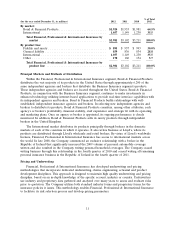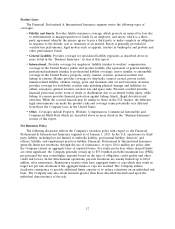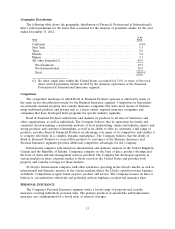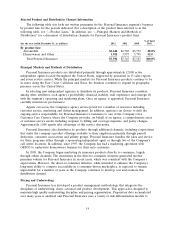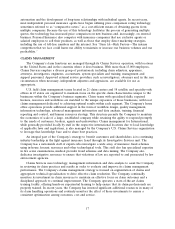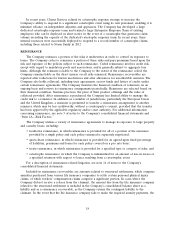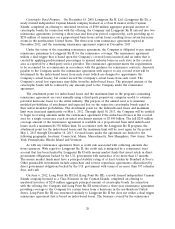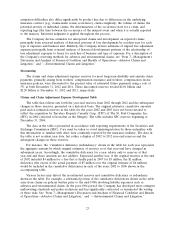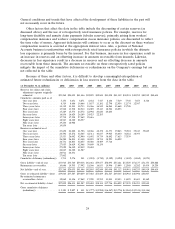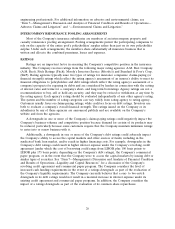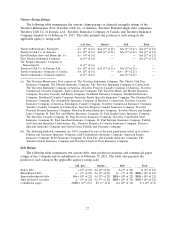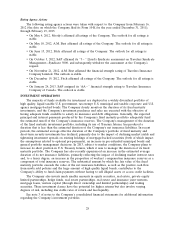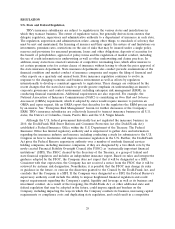Travelers 2012 Annual Report Download - page 33
Download and view the complete annual report
Please find page 33 of the 2012 Travelers annual report below. You can navigate through the pages in the report by either clicking on the pages listed below, or by using the keyword search tool below to find specific information within the annual report.agreement comprises specified property and related coverages in the Company’s Personal Insurance
segment, and within the ‘‘Select Accounts’’ and the ‘‘Commercial Accounts’’ business groups within the
Company’s Business Insurance segment. Covered losses under the agreement are limited to the
following geographic locations: Connecticut, Delaware, District of Columbia, Maine, Maryland,
Massachusetts, New Hampshire, New Jersey, New York, Pennsylvania, Rhode Island, Virginia and
Vermont. Coverage under the agreement is subject to a $2.0 billion retention, after which the Company
is entitled to recover 50% of losses, up to a maximum recovery of $250 million. The attachment point,
maximum limit and insurance percentage are reset annually to maintain modeled probabilities of
attachment and expected loss on the respective catastrophe bonds equal to the initial modeled
probabilities of attachment and expected loss. Similar to Longpoint Re II, in Long Point Re III the
proceeds of the offering were deposited in a reinsurance trust account. In addition, the permitted
investments for such proceeds are of the same type as in Longpoint Re II in all material respects,
except that in Long Point Re II the money market funds must always be rated at least AAAm by
Standard & Poor’s, and in Long Point Re III, the money market funds must have been rated AAAm by
Standard & Poor’s on the issuance date of the bonds and thereafter must be rated by Standard &
Poor’s. The reinsurance agreement meets the requirements to be accounted for as reinsurance in
accordance with the guidance for reinsurance contracts.
At the time the agreements were entered into with Longpoint Re II and Long Point Re III, the
Company evaluated the applicability of the accounting guidance that addresses variable interest entities
or VIEs. Under this guidance, an entity that is formed for business purposes is considered a VIE if:
(a) the equity investors lack the direct or indirect ability through voting rights or similar rights to make
decisions about an entity’s activities that have a significant effect on the entity’s operations, or (b) the
equity investors do not provide sufficient financial resources for the entity to support its activities.
Additionally, a company that absorbs a majority of the expected losses from a VIE’s activities or is
entitled to receive a majority of the entity’s expected residual returns, or both, is considered to be the
primary beneficiary of the VIE and is required to consolidate the VIE in the company’s financial
statements.
As a result of the evaluation of the reinsurance agreements with Longpoint Re II and Long Point
Re III, the Company concluded that they were VIEs because the conditions described in items (a) and
(b) above were present. However, while Longpoint Re II and Long Point Re III were determined to be
VIEs, the Company concluded that it did not have a variable interest in the entities, as the variability
in their results, caused by the reinsurance agreements, is expected to be absorbed entirely by the
investors in the catastrophe bonds issued by Longpoint Re II and Long Point Re III and residual
amounts earned by them, if any, are expected to be absorbed by the equity investors (the Company has
neither an equity nor a residual interest in Longpoint Re II or Long Point Re III).
Accordingly, the Company is not the primary beneficiary of Longpoint Re II or Long Point Re III
and does not consolidate those entities in the Company’s consolidated financial statements.
Additionally, because the Company has no intention to pursue any transaction that would result in it
acquiring interest in and becoming the primary beneficiary of Longpoint Re II or Long Point Re III,
the consolidation of those entities in the Company’s consolidated financial statements in future periods
is unlikely.
The Company has not incurred any losses that have resulted or are expected to result in a recovery
under the Longpoint Re II or Long Point Re III agreements since their inception.
Northeast General Catastrophe Reinsurance Treaty. In addition to its general catastrophe treaty and
its multi-year catastrophe bond program, the Company also is party to a northeast general catastrophe
reinsurance treaty which provides up to $600 million of coverage, subject to a $2.25 billion retention,
for certain losses arising from hurricanes, tornados, hail storms, earthquakes and winter storm or freeze
losses from Virginia to Maine for the period July 1, 2012 through June 30, 2013. Losses from a covered
21


